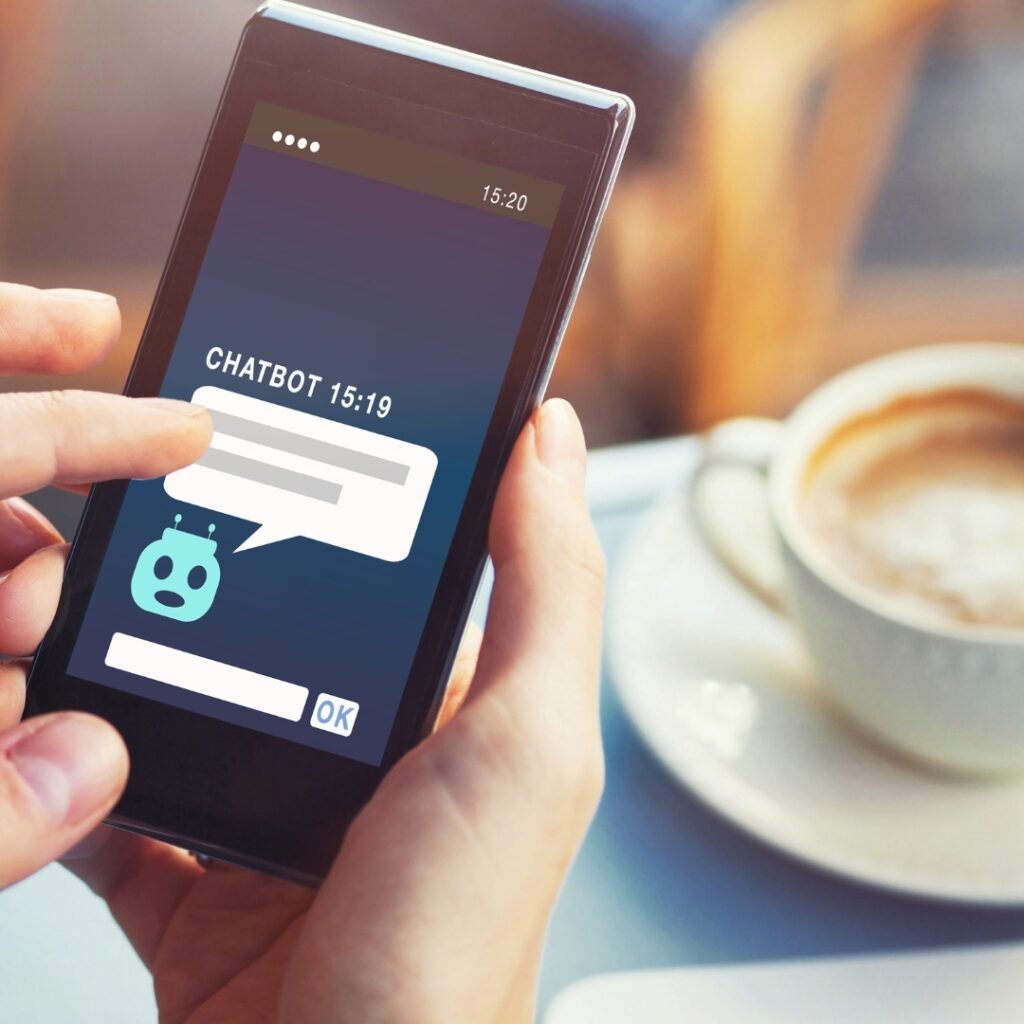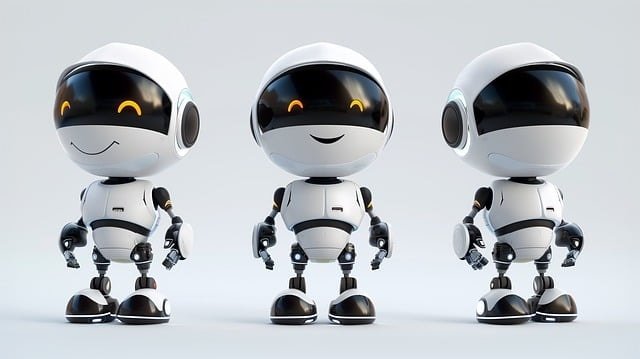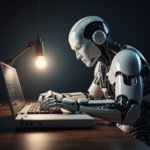Introduction
Curious about how AI chatbots work? Let’s dive into the world of artificial intelligence and chatbots to uncover the magic behind these virtual assistants.
The Basics of AI Chatbots
At the core, AI chatbots are clever pieces of software designed to chat like humans do. These aren’t your average programs; they’re built on natural language processing (NLP). NLP is the brain behind the operation, helping chatbots grasp what we’re saying and how to hit back with something that makes sense. Imagine having a conversation with a friend. That’s the level of smoothness good AI chatbots aim for.
Breaking it down, these chatbots come in two flavors. First up, the rule-based types. They work off a script, so if you say “X,” they reply with “Y.” Simple but somewhat limited. Then there’s the more advanced crew, AI-powered chatbots. These ones really get the party started. They don’t just follow a script; they use machine learning to get the hang of how we talk and what we might be asking for, even when we’re not super clear about it.
Think of it like teaching a new language to someone. At first, they might only understand basic phrases. But, with time and practice, they start picking up on nuances and slang, responding in ways that feel more natural and less like a textbook. That’s machine learning at work in chatbots. They sift through tons of conversation data, learning as they go, which helps them get better at predicting and mimicking human-like responses.
Learning from the Data
But it’s not all smooth sailing. Chatbots need a lot of data to learn from, and not just any data. They need quality conversations that represent a wide variety of human interactions. This helps them not just understand the words but get the context and emotion behind them, which is key to making interactions feel more genuine.
In essence, AI chatbots are like sponges for human conversation. They absorb, learn, and evolve, aiming to make your chat experience as seamless and helpful as possible. Whether you’re asking for weather updates or need help troubleshooting a product, these chatbots are on a mission to make sure you feel heard and helped, all without hitting a “Please hold” message.
General Features
| Feature | Rule-Based Chatbots | AI-Powered Chatbots |
|---|---|---|
| Primary Function | Follow pre-defined scripts | Learn and adapt through interactions |
| Core Technology | Decision trees, scripts | Machine Learning, Natural Language Processing (NLP) |
| Complexity of Responses | Limited to pre-set answers | Can understand context and provide nuanced responses |
| Learning Capability | None | Continuous improvement with more data |

Understanding Natural Language Processing (NLP)
Ever wondered how AI chatbots understand what we’re saying? The secret sauce is Natural Language Processing, or NLP for short. It’s what makes chatbots seem almost human in their responses. NLP is a bit like a decoder ring for chatbots. It helps them break down and interpret the words we type or say into something they can understand.
But NLP isn’t just about understanding single words. It’s about grasping the full picture. Think about how the same word can have different meanings based on context. For example, “light” can mean not heavy or it can refer to brightness. NLP enables chatbots to figure out which meaning makes sense in the conversation.
And there’s more to it. NLP also allows chatbots to catch on to our grammar and slang. This is crucial. Without it, chatbots might get lost in translation, so to speak. They use this skill to piece together appropriate responses that fit the conversation’s flow. It’s like they’re part of the chat, adding to the discussion rather than just reacting to it.
Here’s where it gets even more interesting. NLP isn’t static. It’s always learning from new interactions. This means the more we chat with these AI companions, the better they get at understanding and replying. It’s a bit like teaching a friend slang from your hometown. At first, they might not get it, but over time, they’ll start using it just like a local.
In essence, NLP is the brainpower behind chatbots’ ability to process and engage in human-like conversations. It’s a complex blend of language understanding and machine learning, making our interactions with AI chatbots smoother and more natural. So, next time you’re chatting with a bot, remember there’s a whole lot of NLP magic happening behind the scenes to keep the conversation going.

The Learning Process of AI Chatbots
Chatbots get smarter through chatting with us, kind of like learning by doing. They use a technique called machine learning, which sounds complex but is pretty straightforward. This is where they analyze our conversations, picking up on new phrases and how we use them. It’s a bit like noticing how a friend starts using local slang after moving to a new city.
Here’s a simple breakdown: every time we ask a chatbot something, it tries to match our question with the best response from what it already knows. If the chatbot’s response isn’t quite right, it takes note of where it went wrong. Over time, with lots of interactions, it starts to see patterns. This is machine learning in action – the chatbot adjusts its responses based on past conversations. The goal is to make future interactions more on point.
But it’s not just about right or wrong answers. Chatbots also pay attention to the context of our questions. This means they’re learning not just to understand the words we use, but also the meaning behind them. For example, if we ask about the weather, the chatbot learns we’re probably looking for a forecast, not a discussion on climate change.
How Machine Learning Helps
Machine learning lets chatbots handle a wider range of questions over time. They start with a basic understanding, but as more people chat with them, they gather a treasure trove of data. This data helps them respond in ways that feel more tailored to each person. So, the more we interact with them, the better they get at predicting what we want to know. It’s a continuous cycle of chat, learn, and improve.
This process is what makes chatbots more helpful and less like talking to a wall. They’re always in learning mode, striving to make our next chat even smoother than the last.
| Process Step | Description |
|---|---|
| Data Collection | Chatbots collect data from user interactions |
| Pattern Recognition | Machine learning algorithms identify patterns in conversations |
| Context Understanding | Chatbots learn to understand the context and intent behind user queries |
| Response Improvement | Based on feedback, chatbots refine their responses over time |
| Continuous Learning | Every new interaction helps improve the chatbot’s accuracy and relevance |

Types of AI Chatbots
In the world of AI chatbots, there are essentially two main players: rule-based and AI-powered. Let’s break down what sets them apart.
Rule-based chatbots are like the reliable old trucks of the chatbot universe. They follow a straightforward path, responding to user inputs based on a set list of instructions. If you ask them a specific question, they search their script and deliver the pre-defined answer linked to that query. Think of them as having a map for every possible turn in a conversation. However, their journey is confined to the roads on that map. This makes them predictable and very useful for straightforward tasks where surprises are few.
On the flip side, we have the AI-powered chatbots. These are the high-tech, self-driving cars of the chatbot world. Instead of relying on a fixed map, they use machine learning to chart their course. This means they can understand context, remember past interactions, and even learn from their mistakes. They’re not limited to pre-set responses. Instead, they analyze the language and intent behind what you’re saying, offering replies that are more nuanced and personalized. The more they chat, the smarter they get, making them ideal for complex and varied interactions.
While rule-based chatbots excel in consistency and reliability for specific tasks, AI-powered chatbots shine in their ability to adapt, learn, and provide more personalized experiences. Each has its strengths, making them suitable for different purposes. Whether you need a straightforward assistant or a sophisticated conversational partner, there’s a type of AI chatbot out there that fits the bill.
The Role of Machine Learning
Machine learning is the secret ingredient that gives AI chatbots their smarts. Imagine it as the chatbot’s school, where it learns not from textbooks, but from real conversations happening every day. This isn’t your usual classroom scenario. Here, chatbots absorb patterns and nuances of human language, making their responses more natural and less robotic.
Think about when you try to learn a new skill. At first, it’s a bit rocky, right? You make mistakes, but then you learn from them. That’s exactly how machine learning works for chatbots. They start off knowing the basics, but as they chat more, they begin to understand the intricacies of language. They notice how certain phrases are used and start applying this knowledge to future conversations.
But here’s the kicker: machine learning isn’t just about memorizing facts or responses. It’s about understanding context. For a chatbot, this could mean recognizing that when you say “It’s raining cats and dogs,” you’re talking about heavy rain, not pets falling from the sky. This level of understanding transforms a simple Q&A session into a dynamic conversation.
The process relies heavily on algorithms—set rules that help the chatbot decide the best response. These algorithms are like the chatbot’s brain, constantly analyzing, learning, and making decisions based on new information. It’s an ongoing cycle of listen, learn, and adapt. This is how chatbots move from giving canned responses to engaging in meaningful interactions.
In this high-tech classroom, every chat is a lesson, and every user interaction is an opportunity to improve. Through machine learning, chatbots are evolving, striving to understand us better and make our digital experiences as seamless as possible. Without machine learning, AI chatbots would be stuck reciting lines, unable to truly interact with us. It’s what makes them an invaluable tool in our ever-connected world.

The Importance of Data in Training Chatbots
Think of data as the food that nourishes AI chatbots, helping them grow smarter and more adept at handling our questions. Without a steady diet of high-quality data, chatbots can’t learn the nuances of human conversation or understand the endless variety of ways we express ourselves. It’s not just about feeding them any data, though. The right kind of data matters. It should be diverse, covering a wide range of topics, languages, and conversational styles. This variety teaches chatbots to be flexible, to recognize and respond to different types of queries more effectively.
Consider how we learn as humans. Just as we benefit from rich, varied experiences, chatbots thrive on a diverse data set. This helps them avoid getting stumped by less common questions or phrases. But it’s not just about quantity; quality plays a crucial role too. Clean, well-organized data ensures that chatbots learn from accurate and relevant examples. This keeps their responses on point and useful, rather than leading them down a path of confusion or, worse, misinformation.
In this process, data acts as a bridge between human language and machine understanding. It translates our complex, often messy ways of communicating into something chatbots can grasp and learn from. By analyzing conversations, chatbots detect patterns and start to grasp the intent behind our words, allowing for more accurate and contextually appropriate responses.
| Aspect | Description |
|---|---|
| Data Quality | High-quality, diverse data ensures chatbots learn effectively |
| Contextual Data | Data must include varied contexts to help chatbots understand different scenarios |
| Continuous Data Feed | Regular updates with new data help chatbots stay relevant and improve |
However, this data-driven learning isn’t a one-time event. It’s ongoing, with chatbots continually adjusting and improving based on new information. This constant evolution is what keeps them relevant and effective as our ways of communicating change over time. So, the next time you chat with an AI, remember the pivotal role of data in shaping that interaction. It’s the backbone of their learning journey, making every conversation smoother and more natural than the last.
Challenges Faced by AI Chatbots
Navigating the world of AI chatbots isn’t always a walk in the park. Even the smartest chatbots bump into hurdles. For starters, grappling with complex questions throws them for a loop. Sometimes, what we ask isn’t straightforward. It’s these twists and turns in conversation that chatbots find tricky to follow.
Language adds another layer of complexity. With hundreds of languages and dialects worldwide, ensuring a chatbot can understand and respond accurately across different tongues is no small feat. It’s not just about knowing the words but capturing the essence of what’s being said.
Keeping track of a conversation’s thread is yet another challenge. Imagine talking to someone who forgets what you were discussing two sentences ago. Frustrating, right? That’s how it feels when a chatbot loses the plot mid-conversation. Maintaining context, especially in long or detailed exchanges, tests a chatbot’s memory and processing skills.
Another roadblock is sarcasm and humor. We humans love to sprinkle our chats with witty remarks, a challenge for chatbots that take things literally. Deciphering these nuances requires a level of understanding that chatbots are still catching up on.
Adding the Complexities of Cultural Differences
And let’s not forget about cultural differences. What’s considered polite or offensive varies greatly across cultures. Chatbots need to be sensitive to these differences to avoid misunderstandings or offending someone unintentionally.
Lastly, privacy and security are paramount. With chatbots accessing vast amounts of personal data, ensuring this information is safe and used ethically is a significant concern. Users want to know their conversations are private and their data protected, a responsibility chatbots and their creators must take seriously.
Each of these challenges is a stepping stone toward creating more advanced, understanding, and helpful AI chatbots. As technology evolves, so too will the solutions to these hurdles, paving the way for even smarter and more intuitive chatbot interactions in the future.
| Challenge | Description |
|---|---|
| Complex Queries | Difficulty in handling highly complex or ambiguous questions |
| Language Variability | Challenges in understanding and responding accurately across different languages |
| Maintaining Context | Issues in keeping track of conversation context, especially in long interactions |
| Understanding Humor and Sarcasm | Difficulty in detecting and appropriately responding to sarcasm and humor |
| Cultural Sensitivity | Ensuring responses are culturally appropriate and sensitive |
| Privacy and Security | Safeguarding user data and ensuring ethical use |

The Best AI Chatbot on the Market
In the bustling world of AI chatbots, ChatGPT steals the spotlight. Its knack for mimicking human conversation thanks to advanced NLP sets it apart. But what makes ChatGPT the go-to choice? For starters, its ability to grasp context and nuance in our chats is unmatched. Unlike its counterparts, ChatGPT doesn’t just respond; it understands, making interactions feel more like talking to a friend than a machine.
Its versatility is another key player. Whether you’re looking for customer service, a chatty companion, or assistance with various tasks, ChatGPT fits the bill. It’s this adaptability that has businesses and individuals alike turning to ChatGPT for their chatbot needs.
Ease of use is also a major plus. You don’t need to be a tech wizard to get ChatGPT up and running. Whether it’s integrating it into a website or using it for personal entertainment, the process is straightforward, inviting users from all walks of life to experience AI chat at its best.
Behind the scenes, machine learning fuels ChatGPT’s continuous improvement. Each interaction is a learning opportunity, helping it become more attuned to users’ preferences and ways of speaking. This ongoing evolution means ChatGPT is always getting better, more intuitive, and more responsive to the unique ways people communicate.
In Summary
Finally, ChatGPT’s approach to privacy and data security reassures users that their conversations remain private and protected. In today’s digital age, this commitment to safeguarding user information is crucial, making ChatGPT not just the smartest, but also the safest choice on the market.
| Chatbot | Description | Key Features | Use Cases |
| ChatGPT | Advanced AI chatbot by OpenAI, known for its natural language processing and contextual understanding. | -Advanced NLP Context retention -Versatile applications -Easy integration -Personalized responses | Customer service, personal assistant, content creation |
| Watson Assistant | IBM’s AI chatbot designed for complex integrations and enterprise use. | -Advanced NLP -Contextual understanding -Multi-channel support -Easy integration with enterprise systems | Customer service, IT support, sales |
| Google Dialogflow | Google’s chatbot development platform with robust NLP capabilities and integration options. | -Multilingual support -Natural language understanding -Integration with Google services -Contextual follow-ups | Customer service, IoT device interactions, mobile apps |
| Microsoft Bot Framework | Comprehensive framework by Microsoft for building intelligent bots. | -Integration with Microsoft services -Advanced NLP -Supports multiple channels -Developer-friendly | Enterprise solutions, customer service, productivity tools |
| Rasa | Open-source framework for building AI chatbots with customizable options. | -Open-source -Highly customizable -Advanced NLP -Contextual dialogues -Multi-language support | Customer service, developer customization |
| Tars | User-friendly chatbot platform focusing on lead generation and customer service. | -Easy to use -Drag-and-drop builder -Pre-built templates -Analytics and reporting -Multi-channel support | Lead generation, customer service, marketing |
| Ada | AI-powered chatbot focused on customer service and support automation. | -User-friendly -No-code interface -Advanced analytics -Personalization -Integration with CRM systems | Customer service, IT support, HR automation |
| Zendesk Answer Bot | Chatbot integrated into Zendesk’s customer service platform for streamlined support. | -Seamless Zendesk integration -Advanced NLP -Automated ticket resolution -Multi-language support | Customer support, ticketing systems |
| Intercom | Conversational relationship platform with integrated chatbot capabilities. | -Business messaging -Automated workflows -Customizable chatbots -Integration with CRM -Analytics | Customer service, sales, marketing |
| LivePerson | AI chatbot platform designed for enterprise customer service and engagement. | -Advanced AI Conversational AI -Multi-channel support -Integration with enterprise systems – Analytics | Customer service, sales, IT support |
Future Trends in AI Chatbots
The road ahead for AI chatbots is lined with innovation and excitement. Picture chatbots that not only converse but also anticipate your needs before you even voice them. This isn’t a far-off dream. With the rapid pace of advancements in technology, AI chatbots are set to become more intuitive, acting as personal assistants that understand you better than ever.
Imagine waking up to a chatbot that has already read your schedule, checked the weather, and suggests you take an umbrella because it noticed rain in the forecast. This level of personalization and foresight is where AI chatbots are headed, thanks to deeper learning capabilities and more sophisticated algorithms.
Interactivity will reach new heights. Chatbots will evolve from simple text-based interfaces to engaging multimedia platforms. They’ll use images, videos, and interactive elements to communicate, making the experience richer and more engaging. This shift will transform how we think about chatbots, from mere text messengers to dynamic interactive agents.
The Role of Voice Technology
Voice technology will also play a bigger role. As voice assistants become more common, AI chatbots will seamlessly integrate voice recognition, making interactions even more natural and hands-free. This will be especially useful in situations where typing isn’t practical, opening up new possibilities for how and where we use chatbots.
Another exciting development is the increasing use of chatbots in mental health support. With advancements in understanding and processing human emotions, chatbots will offer a new level of emotional support, providing a listening ear and helpful advice anytime, anywhere.
AI chatbots will also become more ethical and responsible. As we entrust them with more personal tasks and information, ensuring they operate in an ethical, secure manner becomes paramount. Future chatbots will prioritize user privacy and data security, employing advanced measures to keep user information safe and secure.
In essence, the future of AI chatbots is about creating experiences that are not just helpful but truly transformative, enriching our lives in ways we’re just beginning to imagine.
| Trend | Description |
|---|---|
| Increased Personalization | Chatbots will offer more tailored experiences based on individual user preferences |
| Multimedia Integration | Use of images, videos, and interactive elements to enhance user interaction |
| Enhanced Voice Recognition | Improved voice technology for more natural and seamless voice interactions |
| Mental Health Support | Chatbots providing emotional support and mental health resources |
| Ethical AI Development | Greater focus on ethical use and privacy protection |

How to Choose the Right AI Chatbot for Your Needs
Deciding on an AI chatbot can feel overwhelming. Yet, with some guidance, it’s a breeze. Think about what you want the chatbot to do. Is it answering customer service questions, engaging website visitors, or acting as a conversational companion? The chatbot’s function will steer your choice.
Next, consider integration. The ideal chatbot should easily fit into your current systems without causing headaches. Look for options that promise a smooth setup. Customization is another key aspect. You want a chatbot that can adapt to your brand’s voice and meet your users’ specific needs. A one-size-fits-all approach rarely works well.
Price also plays a role. There’s a wide range of free and paid chatbots. While free options are tempting, ensure they meet your requirements. Paid versions often offer more features and better support.
Don’t forget about user experience. Try out different chatbots to see which feels most natural and helpful. A clunky chatbot can drive people away instead of engaging them.
Choosing the Right AI Chatbot
| Consideration | Description |
|---|---|
| Purpose | Determine what the chatbot will be used for (customer service, personal assistant, etc.) |
| Integration | Ensure the chatbot can easily integrate with existing systems |
| Customization | Look for customization options to match your brand’s voice and user needs |
| Pricing | Evaluate cost vs. features to find a balance that fits your budget |
| User Experience | Test different chatbots for ease of use and natural interaction |
| Scalability | Choose a chatbot that can grow and evolve with your needs |
Lastly, think about the future. Choose a chatbot that can grow with you. Look for platforms known for updates and improvements. This ensures your chatbot remains useful as your needs evolve.
By keeping these factors in mind, you’ll find a chatbot that not only meets your current needs but also supports your growth in the long run.
Share this information and please subscribe to our newsletter and website.









